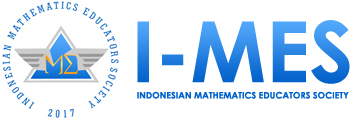The Effect Of STEM-Based Project-Based Learning In Improving High School Students' Visual Mathematical Ability
DOI:
https://doi.org/10.35706/sjme.v7i2.8934Abstract
This research is based on the problem of the low mathematical visual thinking ability in learning mathematics. To overcome this, research was carried out using a STEM-based Project-Based Learning (PjBL-STEM) model. This study examines the problem of improving visual mathematical abilities among students who receive mathematics learning with the STEM-based Project-Based Learning (PjBL-STEM) model. This research is quasi-experimental, the design used is the Nonequivalent Control Group Design using the Purposive Sampling technique. The population in this study were high school students in Bandung Regency in the academic year 2021/2022, with the research sample being high school students in class X. The instrument used in the study was a visual mathematical ability test. Data analysis was carried out quantitatively by using the Independent Sample t-test. The results showed that (1) Overall the application of the PjBL-STEM learning model could improve students' mathematical visual thinking abilities, (2) Improved mathematical visual thinking skills of students whose learning using the PjBL-STEM learning model was significantly better than students who learned using conventional learning models.
Downloads
References
Aini, S. D., & Hasanah, S. I. (2019). Berpikir Visual dan Memecahkan Masalah: Apakah Berbeda Berdasarkan Gender? JNPM (Jurnal Nasional Pendidikan Matematika), 3(2), 177. https://doi.org/10.33603/jnpm.v3i2.2192
Ambarwati, R., Dwijanto, D., & Hendikawati, P. (2015). Keefektifan model Project-Based Learning berbasis GQM terhadap kemampuan komunikasi matematis dan percaya diri
siswa kelas VII. Unnes Journal of Mathematics Education, 4(2), 180-186. https://doi.org/10.15294/ujme.v4i2.7601
Ariawan, R. (2017). Pengaruh pembelajaran visual thinking disertai aktivitas quick on the draw terhadap kemampuan pemecahan masalah dan komunikasi matematis. Jurnal Penelitian dan Pembelajaran Matematika, 10(1). https://doi.org/10.30870/jppm.v10i1.1193
Darmadi, & Handoyo, B. (2016). Profil Berpikir Visual Mahasiswa Calon Guru Matematika Dengan Gaya Belajar Visual dalam Menyelesaikan Masalah Triginometri. Jurnal Matematika Kreatif-Inovatif, 02(01), 75–84. UPI : Tidak Diterbitkan.
Priatna, N., & Sari, R. M. M. (2022). Analyzing students' mathematical spatial https://ojs.unpkediri.ac.id/index.php/matematika/article/view/396
Erdogan, N., & Bozeman, D. (2015). Models of project-based learning for the 21st century. In A. Sahin (Ed.), A practice-based model of STEM teaching: STEM students on the stage (S.0.S.) (p. 31-42). Sense Publishers
Husamah, H. (2015). Blended project based learning: Metacognitive awareness of biology education new students. Journal of Education and Learning (EduLearn), 9 (4), 274-281. https://doi.org/10.11591/edulearn.v9i4.2121
Muflihatussyarifah.(2016). Visual thinking dan habits of striving for accuracy and precision siswamelalui model core disertai aktivitas quick on the draw. Tesis literacy using a project-based blended learning model. Kreano Jurnal Matematika Kreatif Inovatif, 13 (1), 78-87. https://doi.org/10.15294/kreano.v13i1
Priatna, N. ., Avip, B. ., & Mulyati Mustika Sari, R. (2022). Efektifitas Project Based Learning-STEM dan Pemecahan Masalah Matematis Siswa pada Materi Trigonometri. SJME (Supremum Journal of Mathematics Education), 6(2), 151–161. https://doi.org/10.35706/sjme.v6i2.6588
Ruseffendi, H. E. T. (2005). Dasar-dasar Penelitian Pendidikan dan Bidang Non-Eksakta Lainnya. Bandung: Tarsito.
Sari, R. M. M., & Priatna, N. (2020). Blended learning: A strategy of current mathematics learning. Journal of Physics: Conference Series, 5th Seminar Nasional Matematika dan Pendidikan Matematika, 1663. https://10.1088/1742-6596/1663/1/012049
Sari, R. M. M., Priatna, N., & Juandi, D. (2022). Implementing project-based blended learning model using cognitive conflict strategy to enhance students’ mathematical spatial literacy. European Journal of Educational Research, 11(4), 2031-2041. https://doi.org/10.12973/eu-jer.11.4.2031
Shadiq, F. (2009). Aplikasi teori belajar [Learning theory application]. Depdiknas, P4TK Matematika Yogyakarta.
Shadish, W. R., Cook, T. D., & Campbell, D. T. (2002). Experimental and quasi-experimental designs for generalized causal inference. Houghton Mifflin.
Trisnawarni, E.C., & Yuniata, T.N.H. (2021). Proses berpikir visual matematis siswa exstrovert dan introvert sekolah menengah atas berdasarkan tahapan bulton. Aksioma Jurnal 10(2). http://dx.doi.org/10.24127/ajpm.v10i2.3489
Wahyudi, Anugraheni & Winato. (2018). Pengembangan model blended learning berbasis proyek untuk menunjang kreatifitas mahasiswa merancang pembelajaran matematika [Developing project-based blended learning models to encourage student creativity in mathematics instruction]. Jurnal Ilmiah Pendidikan Matematika 6(2), 68-81. http://journal.unipma.ac.id/index.php/jipm
Walker, C., Winner, E., Hetlands, L., Simmons, S., & Goldsmith, L. (2011). Visual Thinking: Art Students Have an Advantage in Geometric Reasoning. Scientific Research 2(1), 22-26. https://10.4236/ce.2011.21004
Downloads
Published
How to Cite
Issue
Section
License

This work is licensed under a Creative Commons Attribution-ShareAlike 4.0 International License.
Authors who publish with this journal agree to the following terms:
- Authors retain copyright and grant the journal right of first publication with the work simultaneously licensed under a Creative Commons Attribution License that allows others to share the work with an acknowledgment of the work's authorship and initial publication in this journal.
- Authors are able to enter into separate, additional contractual arrangements for the non-exclusive distribution of the journal's published version of the work (e.g., post it to an institutional repository or publish it in a book), with an acknowledgment of its initial publication in this journal.
- Authors are permitted and encouraged to post their work online (e.g., in institutional repositories or on their website) prior to and during the submission process, as it can lead to productive exchanges, as well as earlier and greater citation of published work (See The Effect of Open Access).











